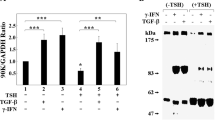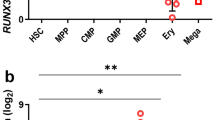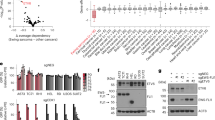Abstract
V-ErbA, a mutated thyroid hormone receptor (TR) α cooperates with tyrosine kinase oncoproteins to induce fatal erythroleukemia in chicks. In vitro, v-ErbA employs a similar cooperation to induce sustained proliferation and arrest differentiation of committed erythroid progenitors. V-ErbA has been proposed to function as a dominant-negative c-ErbA/TRα, since it lacks an AF-2 transactivation domain and cannot be activated by hormone but retains the capacity to bind corepressors. However, v-ErbA fails to heterodimerize with the coreceptor RXR, exhibits an altered DNA binding specificity and fails to suppress the action of coexpressed TRα/c-ErbA in erythroblasts. In this paper, we identify a novel mechanism by which v-ErbA contributes to leukemogenesis. Recently, the glucocorticoid receptor (GR) was identified as a key regulator of proliferation and differentiation in normal erythroid progenitors. For this, the GR required to cooperate with endogenous receptor tyrosine kinases (c-Kit) and with the estrogen receptor (ER). Here, we demonstrate that v-ErbA can substitute for the ligand-activated GR and ER, inducing proliferation and arresting differentiation in the presence of specific GR and ER antagonists. Like the GR, v-ErbA required to cooperate with c-Kit for both proliferation induction and differentiation arrest, being devoid of biological activity in the absence of an active c-Kit. In self-renewing erythroblasts, v-ErbA not only repressed known v-ErbA target genes but also maintained high expression of c-myb. These biological activities of v-ErbA depended on distinct mutations in the DNA-binding domain. Additionally, v-ErbA acted as a partial, weak repressor of c-ErbA/TRα function in normal erythroblasts. It could be converted into a truly dominant-negative receptor by restoring its ability to heterodimerize with RXR.
This is a preview of subscription content, access via your institution
Access options
Subscribe to this journal
Receive 50 print issues and online access
$259.00 per year
only $5.18 per issue
Buy this article
- Purchase on Springer Link
- Instant access to full article PDF
Prices may be subject to local taxes which are calculated during checkout
Similar content being viewed by others
Author information
Authors and Affiliations
Rights and permissions
About this article
Cite this article
Bauer, A., Ulrich, E., Andersson, M. et al. Mechanism of transformation by v-ErbA: Substitution for steroid hormone receptor function in self renewal induction. Oncogene 15, 701–715 (1997). https://doi.org/10.1038/sj.onc.1201208
Received:
Revised:
Accepted:
Issue Date:
DOI: https://doi.org/10.1038/sj.onc.1201208
Keywords
This article is cited by
-
Multiple mutations contribute to repression by the v-Erb A oncoprotein
Oncogene (2005)
-
The v-erbA oncogene blocks expression of α2/β1 integrin a normal inhibitor of erythroid progenitor proliferation
Oncogene (2002)
-
The v-ErbA oncoprotein quenches the activity of an erythroid-specific enhancer
Oncogene (2001)
-
A choice between transcriptional enhancement and repression by the v-erbA oncoprotein governed by one nucleotide in a thyroid hormone responsive half site
Oncogene (2000)



